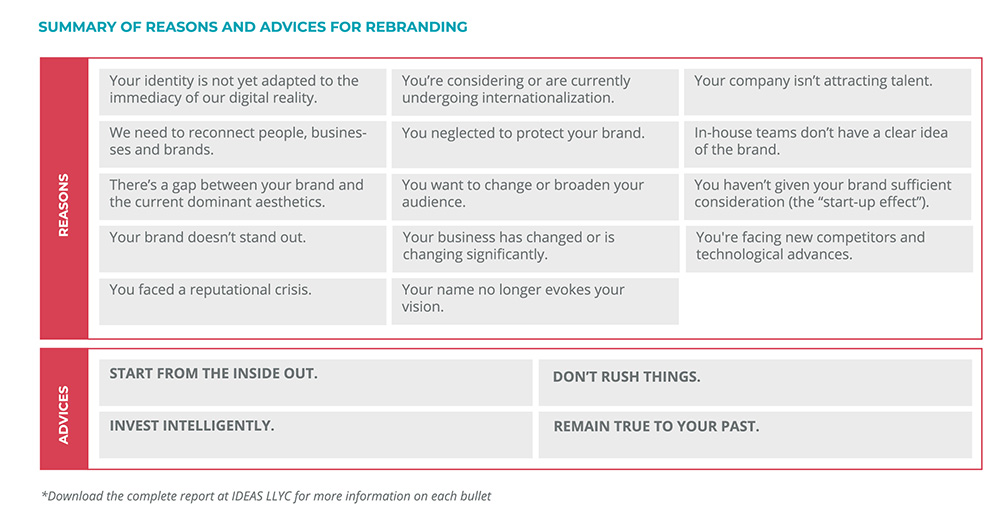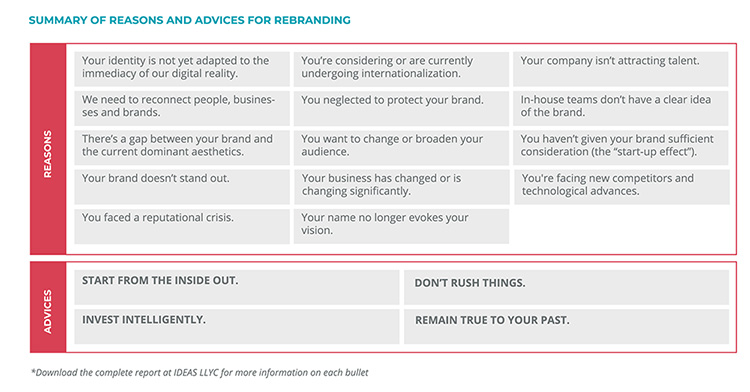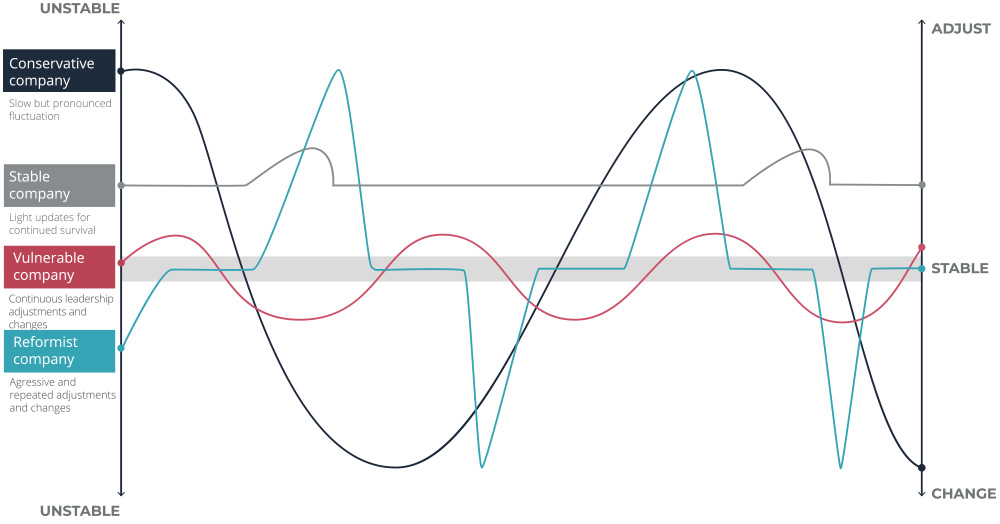-
TrendsCreativeEuropean Affairs
-
SectorIT and Communications
-
CountriesGlobalSpain
When managing a brand, the ability to identify and adapt to a rapidly changing market is paramount. To ensure a brand’s survival in a volatile economy, it must remain nimble, but assessing the practical need for rebranding, and the best way to make significant changes, can be difficult. This report will offer advice on how to determine whether rebranding is necessary, as well as methodology for an efficient and successful rebranding.
When executed well, rebranding can breathe new life into a stagnant business, but a simple logo change and press release do little to affect the company, inside or out. When rebranding, we emphasize evolution of our company’s structure and the creation of innovative strategies in order to maximize efficiency and potential connections with consumers. While cosmetic changes such as logo alteration can aid in this, the essential element is continued and future engagement from consumers. Only when the entirety of the user experience has been enhanced can your company say its rebranding was a success.
But rebranding is not necessarily what every company needs. With every shift your company makes, there is always a change in public perception, which entails risk of alienating existing consumers who may not agree with the new direction the company is taking. A haphazard rebranding can result in loss of sales, diminishing margins and dilution of pricing strategies, so before considering one, ensure that the problem does in fact lie not with operations, marketing or a product, but with the brand itself. A good starting point for determining whether a significant adaptation is necessary for the continued health of your business is to ask yourself these two questions: Does your company’s mission statement no longer represent you? And has your company evolved past what it used to be?
The emotional impression left by a brand or product on consumers tends to diminish over time. This can be a result of messaging that’s generic, is targeted at a specific demographic or has simply been used in the past, all in an attempt to reach more consumers. This strategy, while often effective at first, can erode a brand’s competitive edge, preventing it from standing out from the crowd. Sometimes brands may even fall out of favor due to circumstances outside the company’s control. In these cases in particular, it’s imperative you maintain and manage your brand so as to maximize consistency of value. Even the most ailing company can be revitalized by a well-timed, well-executed rebranding.
All reasons for rebranding ultimately aim to improve business performance, and the core strategies are as follows:
People (employees and customers)
- Attract talent with new skills.
- Increase engagement with specific communities.
- Capture new market demographics.
Business
- Enhance your competitive positioning to maintain or increase market share.
- Extend your activity to new sectors and markets.
- Offer a new product or service that’s more holistic and distinctive.
Brand
- Protect and/or consolidate brand territories and move into new ones to gain new communication networks.
- Strengthen brand equity to reinforce visibility and value.
- Increase brand desirability.



Rebranding Methods
Planning
- Diagnosis: Regularly analyzing the health of your brand allows you to identify how close your desired image is to your public perception. This will also lead to a “brand truth,” which can serve as a framework for sharing your rebranding goals. Brand health analyses will also create manageable metrics and potentially offer new discoveries, allowing you to directly connect your brand to your business performance.
Creation
- Strategic Redefinition. With all this information laid out clearly, determining the best plan of action becomes much simpler. Will you enter into a new field? Will you try to partner with another brand? Will you shift toward a new product or service? At this stage, a redefinition of your Brand Matrix® is paramount to ensure your rebranding has long-term results.
- Visual and Verbal Redefinition. Many strategic evolution processes fail to reach their full potential due to a lack of support from a sufficient visual evolution. Changes to visual expression are an extremely effective way to ensure a cohesive rebranding.
Implementation
- There any many necessities to consider before launching your new brand and migrating your brand’s points of contact. The transition inherent to rebranding is no easy task, as it uses a significant amount of time and resources. However, precise planning, management and execution can result in a significant impact, driving brand equity and control of investment to offset costs. The transition must include a concrete plan of action that takes into account all potential interactions between customers and your brand. You must foster internal commitment, divide responsibilities among different teams and give priority to your points of contact.
Brand Adjustment vs. Rebranding


The world’s top-ranked companies never stop adapting and evolving. Whatever their strategies for consistent growth, diversification, disinvestment, innovation or specialization may be, their brand always supports them throughout each change, acting like headlights in the fog. The brand acts as an ideal link between company and consumer, inspiring them and guiding them toward a better future. How you change, adapt or evolve is up to you, but to stay competitive, there’s no other option.



